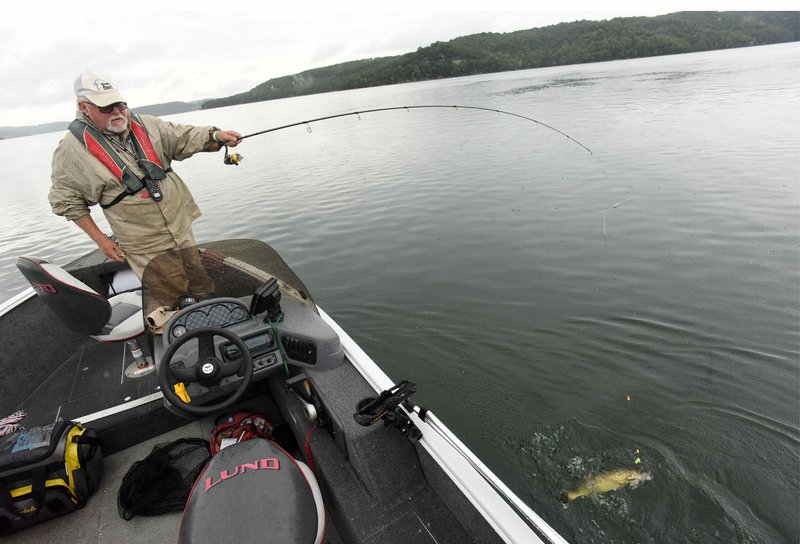The fish Robert Smith likes to catch ought to be labeled "handle with care."
Smith, of the Hickory Creek community, goes after walleye at Beaver Lake. They sport a mouth full of teeth and sharp gill plates. Fins are like needles. Walleye are also a fun to catch and one of the tastiest fish in fresh water.
Catch a walleye
Beaver Lake is home to a thriving population of walleye. Walleye at the lake and its triburaties must be 18 inches or longer to keep. The daily limit is four.
Source: Arkansas Game and Fish Commission
Smith has a knack for catching them at Beaver Lake using a technique that's popular up North where the toothy fish is king. No matter where a walleye dwells, a live nightcrawler puts it in the boat.
The technique is simple. Smith ties his fishing line to a bottom bouncer for weight. A nightcrawler harness is attached to the bottom bouncer, then Smith slow-trolls the whole rig.
Say what?
A bottom bouncer looks like a foot-long length of wire bent in an L shape. There's a thin lead weight on one piece of the wire. The other piece of wire has a swivel on the end.
The nightcrawler harness is a length of fishing line about three feet long. There's a loop on one end that attaches to the swivel on the bottom bouncer.
On the other end is a small spinner, some colored beads and two hooks.
Smith threads a juicy nightcrawler on the two hooks so the crawler is fairly straight. The spinner and beads are attractors that get a walleye's attention. Smith lowers the bouncer and nightcrawler harness to the bottom and trolls at 1 mph.
"That's the slowest you can troll where that spinner will still spin," Smith said on a rainy Friday afternoon in August at Beaver Lake. "The idea with the bottom bouncer is just what it says. You want to feel it ticking along the bottom. Tick, tick tick."
The design of the bottom bouncer keeps the nightcrawler harness slightly above the lake bottom as it's trolled. You Tube videos show the bottom bouncer and harness at work underwater, with walleye biting the nightcrawler.
The magic depth during summer and early fall is 25 to 30 feet. Smith likes to fish points along the main lake that are near deep water.
Ah, but the walleye sleuth has other pet spots, places that most anglers don't even know are there. Smith made a bee line for one near Rocky Branch park. In fifteen minutes, he coaxed walleye number one toward his boat far off shore
"What we've got here is an underwater hump that's close to very deep water," Smith coached, admiring the walleye's beautiful golden color. The fish was a keeper, a tad over 18 inches long.
"That fish came out of 29 feet of water. The line just felt heavy, so I moved it forward a little," Smith said. "That made him jerk, and I set the hook."
In a couple of hours, Smith caught five more walleye from his off-shore hot spot, including another solid keeper that went into his ice chest.
"They're definitely stacked up in here," Smith said. His half-dozen walleye all bit within 40 yards of each other.
Smith uses a two-ounce bottom bouncer when he fishes 25 to 30 feet deep. He makes his own nightcrawler harnesses, but they're available at area fishing stores. So are bottom bouncers.
Some area shops are stocking walleye tackle now that the fish are firmly established at Beaver Lake. They were native to the White River, but pretty much vanished as the lake aged after it was formed in the mid-1960s.
The Arkansas Game and Fish Commission began stocking walleye years ago. Now the lake has a good population of them that reproduce on their own, said Jon Stein, Northwest Arkansas' fisheries biologist with Game and Fish.
About 100,000 walleye fingerlings are still stocked into the lake each year to boost numbers.
"It could be that one day they'll reproduce on their own enough that we won't stock them," Stein said.
Smith said he's no biologist, but he'd like to see the regulation changed to allow anglers to keep four walleye per day 17 inches or longer, but only one over 20 inches. That would give more protection to the large spawning fish, he added.
Stein said anglers catch a lot of 17 inch walleye by accident when they're fishing for other species like black bass or crappie. Anglers of all stripes would likely keep every 17-inch walleye they caught because they're so good to eat. That could result in over harvest.
Walleye research at the lake doesn't show a need to restrict the harvest to one fish over 20 inches, Stein said.
The mantra this time of year is the early birds catch the fish. Not so with walleye. Most days Smith hits the lake at mid-morning. Some of his best fishing has been in the afternoon.
As the water cools during autumn, Smith will keep feeding nightcrawlers to those walleye. He'll fish more shallow and will also start trolling for walleye with brightly colored crank baits.
Sports on 09/17/2019
